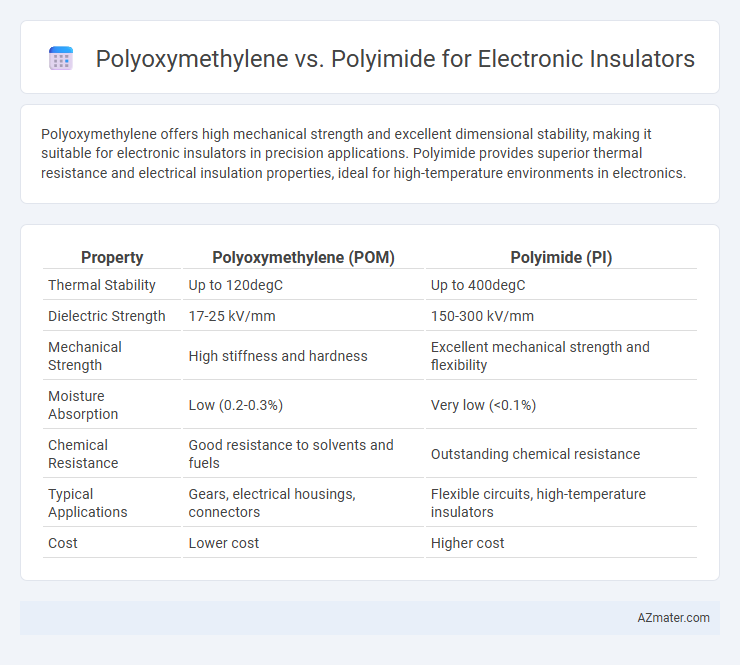Polyoxymethylene offers high mechanical strength and excellent dimensional stability, making it suitable for electronic insulators in precision applications. Polyimide provides superior thermal resistance and electrical insulation properties, ideal for high-temperature environments in electronics.
Table of Comparison
| Property | Polyoxymethylene (POM) | Polyimide (PI) |
|---|---|---|
| Thermal Stability | Up to 120degC | Up to 400degC |
| Dielectric Strength | 17-25 kV/mm | 150-300 kV/mm |
| Mechanical Strength | High stiffness and hardness | Excellent mechanical strength and flexibility |
| Moisture Absorption | Low (0.2-0.3%) | Very low (<0.1%) |
| Chemical Resistance | Good resistance to solvents and fuels | Outstanding chemical resistance |
| Typical Applications | Gears, electrical housings, connectors | Flexible circuits, high-temperature insulators |
| Cost | Lower cost | Higher cost |
Introduction to Polyoxymethylene and Polyimide
Polyoxymethylene (POM) is a high-performance engineering thermoplastic known for its excellent dimensional stability, low friction, and high mechanical strength, making it ideal for precise electronic insulator components. Polyimide (PI) offers superior thermal stability, exceptional electrical insulation properties, and resistance to harsh chemical environments, commonly used in flexible circuits and high-temperature electronics. Both materials serve critical roles in electronic insulation, with POM favored for mechanical robustness and PI preferred for high-temperature and chemically demanding applications.
Chemical Structure Comparison
Polyoxymethylene (POM) features a linear polymer chain with repeating -CH2-O- units, providing high crystallinity and rigidity that contribute to excellent dimensional stability and low moisture absorption. Polyimide (PI) consists of aromatic rings linked by imide groups, offering superior thermal stability and chemical resistance due to its rigid and planar molecular structure. The presence of strong covalent bonds in polyimide enhances its insulating properties at elevated temperatures, whereas polyoxymethylene's simpler backbone ensures cost-effective and mechanically robust insulating performance.
Thermal Stability and Heat Resistance
Polyimide exhibits superior thermal stability compared to polyoxymethylene, maintaining structural integrity at temperatures exceeding 300degC, whereas polyoxymethylene typically degrades around 120-150degC. The high heat resistance of polyimide makes it ideal for electronic insulators operating in extreme thermal environments, offering reliable performance without deformation or loss of insulation properties. Polyoxymethylene's lower heat resistance limits its use in high-temperature electronic applications, making polyimide the preferred choice for demanding thermal conditions.
Electrical Insulation Properties
Polyoxymethylene (POM) offers excellent dielectric strength and low dielectric constant, making it suitable for general electronic insulator applications with stable electrical insulation properties under varying environmental conditions. Polyimide (PI) exhibits superior thermal resistance and higher dielectric breakdown voltage, enabling reliable insulation performance in high-temperature and high-frequency electronic environments. The choice between POM and PI depends on specific application requirements, with PI favored for demanding electrical insulation needing thermal endurance, while POM suits cost-effective, moderate-performance electronic insulating needs.
Mechanical Strength and Durability
Polyoxymethylene (POM) exhibits high mechanical strength with excellent stiffness and impact resistance, making it suitable for precision electronic insulators requiring dimensional stability under stress. Polyimide, while also mechanically robust, outperforms POM in thermal durability and chemical resistance, maintaining integrity in harsh environments such as high-temperature electronics. For applications demanding long-term mechanical stability combined with superior heat and chemical endurance, polyimide offers enhanced durability compared to polyoxymethylene.
Moisture Absorption and Environmental Resistance
Polyoxymethylene (POM) exhibits low moisture absorption rates around 0.2-0.3%, enhancing its dimensional stability in humid environments but offers moderate resistance to chemicals and UV exposure. Polyimide demonstrates superior environmental resistance with excellent thermal stability, low moisture absorption below 0.5%, and outstanding chemical and radiation resistance, making it ideal for high-performance electronic insulators. The choice between POM and polyimide depends on the specific application's tolerance for moisture-induced expansion and environmental stress factors.
Processing Ease and Manufacturing Flexibility
Polyoxymethylene (POM) offers superior processing ease due to its low melting point around 175degC, enabling faster molding cycles and reduced energy consumption, which is advantageous for mass production of electronic insulators. In contrast, Polyimide (PI) requires high-temperature curing above 250degC and longer processing times, limiting manufacturing flexibility but providing excellent thermal stability and electrical insulating properties. Manufacturers prioritize POM for applications demanding rapid, cost-effective fabrication, while PI suits high-performance insulators needing durability in harsh thermal environments.
Cost Analysis and Market Availability
Polyoxymethylene (POM) offers a cost-effective solution for electronic insulators due to its lower raw material and processing expenses compared to polyimide, which commands higher prices driven by its superior thermal stability and dielectric properties. Market availability of POM is widespread with extensive global production and distribution channels, supporting large-scale applications, while polyimide, though available, is often sourced from specialized suppliers catering to high-performance electronics sectors. Cost analysis favors POM for budget-sensitive projects, whereas polyimide remains the preferred choice where premium insulation performance justifies the investment.
Typical Applications in Electronics
Polyoxymethylene (POM) is widely used in electronic insulators for precision gears, connectors, and structural components due to its high stiffness, low friction, and excellent dimensional stability. Polyimide excels in flexible printed circuit boards, wire insulation, and high-temperature applications because of its superior thermal resistance, excellent dielectric properties, and mechanical strength. Selecting POM or Polyimide depends on operating temperature, mechanical stress, and flexibility requirements in electronic devices.
Summary: Choosing the Best Insulator
Polyoxymethylene (POM) offers excellent mechanical strength and low moisture absorption, making it suitable for applications requiring durability and dimensional stability in electronic insulation. Polyimide excels in thermal stability and chemical resistance, ideal for high-temperature environments where insulation reliability is critical. Selecting the best insulator depends on balancing thermal requirements and mechanical properties specific to the electronic device's operating conditions.

Infographic: Polyoxymethylene vs Polyimide for Electronic Insulator
 azmater.com
azmater.com